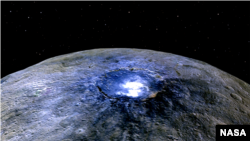When the Dawn spacecraft reached the dwarf planet Ceres in March of 2015 researchers were baffled by the lack of large impact craters, but new research may provide some answers.
Writing in the journal Nature Communications, researchers say the dwarf planet likely “experienced significant geological evolution, possibly erasing the large basins.”
In fact, none of the crater basins are more than 285 kilometers across, but it’s almost certain the planet was struck by large objects over the course of 4.5 billion years.
"When we first started looking at Ceres images, we noticed that there weren't any really large impact basins on the surface,” said David Williams, who is the director of the Ronald Greeley Center for Planetary Studies at Arizona State University's School of Earth and Space Exploration.
"Even Vesta, only about half of Ceres' size, has two big basins at its south pole. But at Ceres, all we saw was the Kerwan Basin, just 177 miles in diameter," Williams said. "That was a big red flag that something had happened to Ceres."
Using computer models, the researchers predicted Ceres should have 10 to 15 craters at least 400 kilometers across and at least 40 craters at least 100 kilometers in diameters, but the Dawn spacecraft spotted 16 craters with diameters of 100 kilometers and none that were bigger than 284 kilometers across.
There are, however three areas with depressions about 800 kilometers wide. These are likely old, as they have smaller craters within them, but researchers say they could be the result of a bigger impact long ago.
"We concluded that a significant population of large craters on Ceres has been obliterated beyond recognition over geological time scales, which is likely the result of Ceres' peculiar composition and internal evolution," said lead author Simone Marchi of the Southwest Research Institute in Boulder, Colorado.
The lack of big craters could be explained in several ways.
For example, if the planet’s crust contains a significant amount of ice mixed with salts, the crust would be weakened, causing a large crater to smooth out over time and possibly disappear.
"If Ceres were highly rocky, we'd expect impact craters of all sizes to be preserved,” Williams said. “Remote sensing from Earth, however, told us even before Dawn arrived that the crust of Ceres holds a significant fraction of ice in some form," Williams said.
Another possibility is that Ceres could have “generated some internal heat from the decay of radioactive elements after it formed.” This, too, could cause impact craters to slowly fade away.
Another explanation is icy volcanism, in which water or brine is spewed from a volcano rather than molten rock.
"It's possible that there are layers or pockets of briny water in the crust of Ceres," says Williams. "Under the right conditions, these could migrate to the surface and be sources for the bright spots."









